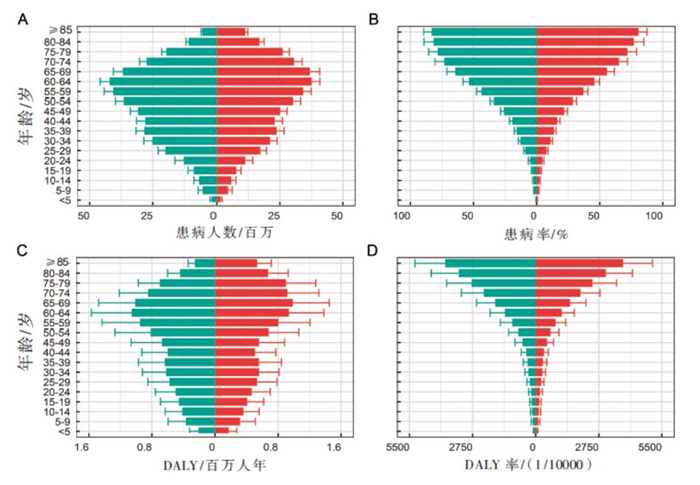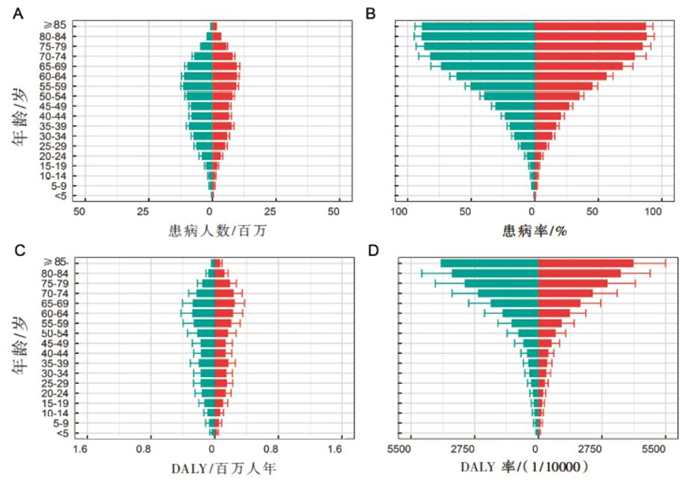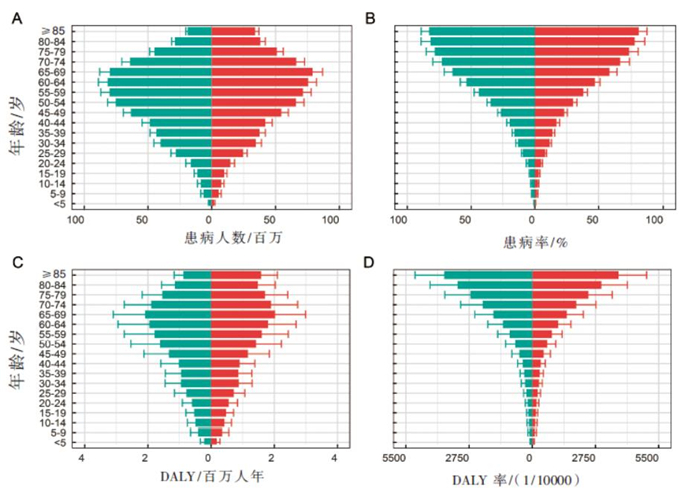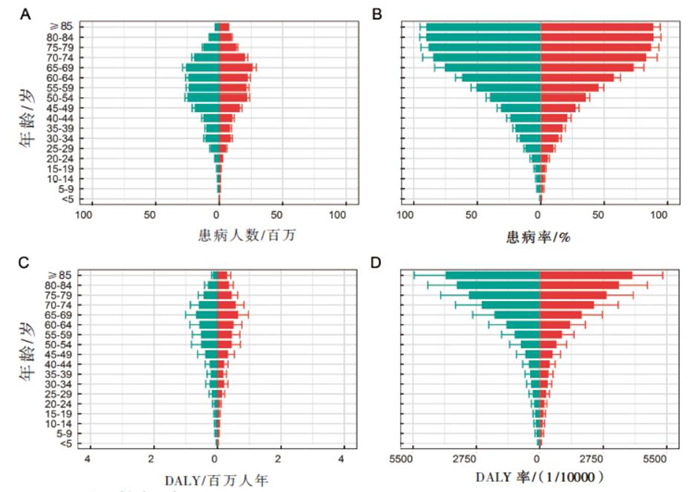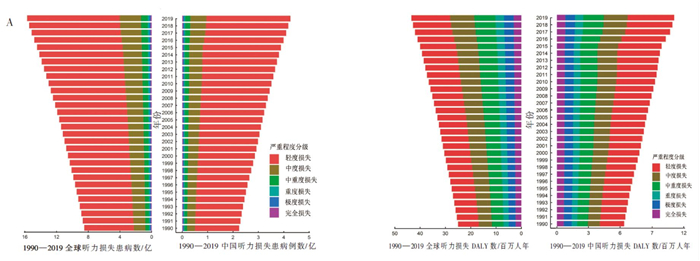Analysis of global and Chinese disease burden of hearing loss from 1990 to 2019
-
+ English摘要:目的 分析1990—2019年全球和中国听力损失疾病负担及其变化趋势,为听力损失防治措施的制定提供数据支持。方法 从2019年全球疾病负担研究数据库(Global Burden of Disease,GBD 2019)中提取出全球和中国听力损失的患病率、伤残调整寿命年等疾病负担指标及年龄、性别等相关信息,分析听力损失疾病负担基本情况、各指标在年龄和性别上的分布及时间变化趋势。结果 1990—2019年,全球听力损失患病人数从7.52亿例增加到14.57亿例,增幅为93.75%;同期中国听力损失患病数从1.99亿例增加到4.07亿例,增幅为104.52%,中国的听力损失人数增幅高于全球。全球听力损失伤残调整寿命年(disability-adjusted life year,DALY)数从22.01百万人年增加到40.24百万人年,增幅为82.83%;同期中国听力损失DALY数从5.58百万人年增加到10.48百万人年,增幅为87.84%。1990—2019年全球和中国听力损失年龄标化患病率(age-standardized prevalence rate,ASPR)均呈上升趋势,中国的上升速度快于全球;年龄标化DALY率(age-standardized DALY rate,ASDR)均呈下降趋势,中国的下降速度快于全球;随着年龄的增加,听力损失患病数和DALY数呈现先升高后降低的趋势;1990年、2019年全球和中国的男性听力损失ASPR均高于同时期女性(P<0.001)。轻度听力损失例数占全部听力损失例数的比例超过70%,但中度及以上听力损失所致DALY超过60%。结论 全球和中国听力损失造成的疾病负担依旧很重,且有进一步增加的趋势。政府部门须采取相应的预防听力损失的措施来控制疾病负担的增长。
-
听力损失常被称为“无形的残障”,因其早期缺乏明显的症状,且长期以来被公共政策制定者所忽视。听力损失是全球第三大致残原因,它影响到各个年龄段的人及其家庭和经济[1]。全球超过15亿人有听力损失,到2050年这一数字可能达到25亿[2]。听力损失如果不加以识别和解决,会对语言发展、心理健康、生活质量、教育成就、生命各个阶段的经济独立性等产生深远的后果[3-5]。由于未能充分解决听力损失问题,在全球范围内估计每年造成高达1万亿美元的经济损失[6]。
2020年由哈佛大学主导的美国健康指标与评估研究所公布了2019全球健康交流数据[7],本研究拟通过提取其中的疾病负担数据,分析1990—2019年间全球和中国听力损失的疾病负担变化情况,以期为听力损失防治措施的制定提供数据支持。
1. 资料与方法
1.1 资料来源
本研究数据来源于2019年全球疾病负担数据库(Global Burden of Disease,简称GBD 2019),此数据库包含1990—2019年的全球疾病负担数据。GBD2019的估算数据基于识别每种疾病或伤害的多个相关数据来源,包括人口普查、家庭调查、民事登记和生命统计、疾病登记、卫生服务记录、空气污染监测、卫星成像、疾病报告等[8]。本研究选取其中的年龄相关和其他听力损失数据进行分析。GBD 2019对中国人群听力损失的疾病负担研究数据包括两部分:第一部分为31个省、自治区、直辖市以及香港和澳门特别行政区,第二部分为中国台湾地区。本研究中国人群疾病负担使用的是第一部分数据。
GBD 2019数据库利用贝叶斯回归分析工具DisMod MR2.1对上述指标进行分析、建模和估算,对世界人口进行标准化,并报告为每10万人口中年龄标准化的患病率和伤残调整寿命年(disability-adjusted life year,DALY)率。建模计算过程中的每个步骤进行1 000次抽样产生了1 000个平均估算值,并据此计算最终估算值,指定1 000个估算值中的第25和第975个值形成每个平均值的95%不确定区间(uncertainty interval,UI)[8]。本研究患病数、患病率、DALY数、DALY率、年龄标化患病率、年龄标化DALY率等均直接来源于GBD 2019数据库,相关数据以数字和95%不确定区间(95% UI)的形式表述。统计维度包括年份、性别、年龄、听力损失严重程度等。
1.2 听力损失的定义及分类
GBD将听力损失定义为个体在最安静的环境下优势耳在0.5、1、2、4 kHz纯音平均听阈高出正常听阈(> 20 dB)的情况,按照其平均听阈值水平划分7个等级,根据损伤程度赋予不同的伤残权重[2],见表 1。
表 1 听力损失程度分级及相应的伤残权重听力损失程度 平均听阈升高水平/dB 伤残权重(95%UI) 正常听力 0~19 0 轻度 20~34 0.010(0.004 ~ 0.019) 中度 35~49 0.027(0.015 ~ 0.042) 中重度 50~64 0.092(0.064 ~ 0.129) 重度 65~79 0.158(0.104 ~ 0.227) 极重度 80~94 0.204(0.134 ~ 0.288) 完全丧失 ≥ 95 0.215(0.143 ~ 0.307) 1.3 疾病负担指标
疾病负担主要评价指标为DALY,其由两部分组成,分别为寿命损失年(years of life lost,YLL)和残疾生存年(years of life lived with disability,YLD),单位为人年。
DALY = YLL + YLD,YLL = N × L,YLD = Nc × DW ×伤残状态持续时间,式中N为各年龄组、不同性别某病的死亡人数;L为各年龄组的寿命损失值,即标准寿命表中该死亡年龄点所对应的期望寿命值。Nc为某病的患病数;DW为伤残权重,数值越大表示生命损失越多,0表示完全健康,1表示死亡[9]。对于非致死性疾病其DALY = YLD。
1.4 数据处理及分析
由于人口结构不同,本研究采用了年龄标化患病率(age-standardized prevalence rate,ASPR)、年龄标化DALY率(age-standardized DALY rate,ASDR)以及估计年度变化百分比(estimated annual percentage change,EAPC)分年龄、性别、严重程度等来评估全球和中国听力损失的疾病负担变化趋势。
年龄标化率(age-standardized rate,ASR)包括ASPR、ASDR,采用如下方法计算:将特定年龄组的患病率或DALY率与所选参考标准人口的同一年龄组中的人数比例乘积即得到年龄标化率:
ASR =某年龄组患病率(或DALY率)×(标准人口相应年龄组人数/标准人口总数)。
EAPC是一个广泛使用的用来衡量特定时间内年龄标化率变化趋势的指标,本研究中用来反映1990—2019年听力损失年龄标化患病率和年龄标化DALY率的变化趋势,其计算方法已在相关文献中进行描述[10-12],本研究按照其方法使用年龄标化率进行计算,简述如下:年龄标化率的年度变化趋势对数值与日历(年份计)符合线性回归模型,即ln(年龄标化率)= α + β ×年份+ ε,EAPC值= 100 ×(eβ-1),其中β为拟合曲线斜率,α为Y轴截距,ε为误差项。若EAPC及其95%CI值均 > 0,可认为相应的年龄标化率呈上升趋势;相反,若EAPC及其95%CI值均 < 0,则认为相应的年龄标化率呈下降趋势。
使用R 4.2.1软件进行统计分析及绘图。不满足正态分布的计量资料,采用中位数和第25、75百分位数[M(P25,P75)]表示,两组间差异采用Wilcoxon秩和检验进行比较,年龄标化率的比较采用χ2检验。以双侧检验P < 0.05为差异有统计学意义。
2. 结果
2.1 全球和中国听力损失疾病负担及变化趋势
1990—2019年,全球听力损失患病人数从7.52(95%UI:7.16 ~ 7.87)亿例增加到14.57(95%UI:13.96 ~ 15.19)亿例,增幅为93.75%;同期中国听力损失患病数从1.99(95%UI:1.90 ~ 2.06)亿例增加到4.07(95%UI:3.90 ~ 4.25)亿例,增幅为104.52%,中国的听力损失人数增幅高于全球水平。见表 2。
表 2 1990年、2019年全球和中国听力损失患病及疾病负担地区 1990年 2019年 EAPC/% 患病情况 伤残调整寿命年(DALY) 患病情况 伤残调整寿命年(DALY) 数量× 108 ASPR/% 数量× 106人年 ASDR/‰ 数量× 106 ASPR/% 数量× 106人年 ASDR/‰ ASPR ASDR 全球 7.52
(7.16 ~7.87)17.33
(16.58 ~ 18.10)22.01
(14.91 ~ 31.34)5.09
(3.47 ~ 7.25)1 456.66
(1 395.61 ~ 1 519.30)17.76
(17.01 ~ 18.52)40.24
(27.39 ~ 57.13)4.99
(3.40 ~ 7.10)0.08
(0.07 ~ 0.10)- 0.07
(- 0.09 ~ - 0.05)中国 1.99
(1.90 ~ 2.08)20.52
(19.60 ~21.42)5.58
(3.74 ~ 7.79)5.89
(4.04 ~ 8.40)407.29(389.93 ~ 425.41) 21.11
(20.24 ~ 22.02)10.48
(7.03 ~ 15.08)5.72
(3.90 ~ 8.15)0.10
(0.07 ~ 0.13)- 0.14
(- 0.19 ~ - 0.10)1990—2019年,全球听力损失DALY数从22.01(95%UI:14.91 ~ 31.34)百万人年增加到40.24(95%UI:27.39 ~ 57.13)百万人年,增幅为82.83%;同期中国听力损失DALY数从5.58(95%UI:3.74 ~ 7.97)百万人年增加到10.48(95%UI:7.03 ~ 15.08)百万人年,增幅为87.84%。见表 2。
1990—2019年,全球听力损失ASPR从17.33%(95%UI:16.58% ~ 18.10%)增加到17.76%(95%UI:17.01% ~ 18.52%),EAPC为0.08%(95%UI:0.07% ~ 0.10%);中国听力损失ASPR从20.52%(95%UI:19.60% ~ 21.42%)增加到21.11%(95%UI:20.24% ~ 22.02%),EAPC为0.10%(95%UI:0.07% ~ 0.13%)。经Wilcoxon秩和检验,中国听力损失ASPR[20.9%(20.7%,21.0%)]高于全球ASPR[17.6%(17.5%,17.7%)],差异有统计学意义(T = 232.5,P < 0.001);EAPC也高于全球水平。见表 2。
1990—2019年,全球听力损失ASDR从5.09‰(95%UI:3.47‰ ~ 7.25‰)下降到4.99‰(95%UI:3.40‰ ~ 7.10‰),EAPC为- 0.07%(- 0.09% ~ - 0.05%);中国听力损失ASDR从5.89‰(95%UI:4.04‰ ~ 8.40‰)下降到5.72‰(95%UI:3.90‰ ~ 8.15‰),EAPC为- 0.14%(- 0.19% ~ - 0.10%);经Wilcoxon秩和检验,中国听力损失ASDR[5.83‰(5.74‰,5.86‰)]高于全球ASDR[5.06‰(5.03‰,5.08‰)],差异有统计学意义(T = 232.5,P < 0.001),但其EAPC下降幅度高于全球水平。见表 2。
2.2 年龄和性别对疾病负担的影响
1990年,全球男性和女性听力损失患病数峰值均出现在60 ~ 64岁年龄组:男性为4 207(95%UI:3 866 ~ 4 582)万例,女性为3 691(95%UI:3 358 ~ 4 076)万例,见图 1(A);粗患病率随年龄的增长而升高,见图 1(B)。听力损失DALY数峰值男性为1.01(95%UI:0.67 ~ 1.48)百万人年,出现在60 ~ 64岁年龄组,女性为0.99(95%UI:0.65 ~ 1.45)百万人年,出现在65 ~ 69岁年龄组,见图 1(C);粗DALY率随年龄的增长而升高,见图 1(D)。
1990年中国听力损失患病数峰值男性和女性略有差异:男性为1 121(95%UI:1 036 ~ 1 219)万例,出现在55 ~ 59岁年龄组;女性为972(95%UI:897 ~ 1 055)万例,出现在60 ~ 64岁年龄组,见图 2(A);粗患病率随着年龄的增长而升高,在80 ~ 84岁年龄组达到峰值,随后出现下降,见图 2(B)。男性听力损失DALY数峰值为0.28(95%UI:0.18 ~ 0.42)百万人年,出现在60 ~ 64岁年龄组;女性为0.25(95%UI:0.17 ~ 0.38)百万人年,出现在65 ~ 69岁年龄组;见图 2(C)。听力损失粗DALY率随着年龄增加而升高,见图 2(D)。
2019年全球听力损失患病数峰值比1990年大幅度增加:男性为8 159(95%UI:7 511 ~ 8 901)万例,出现在60 ~ 64岁年龄组;女性为7 908(95%UI:7 198 ~ 8 206)万例,出现在65 ~ 69岁年龄组,见图 3(A)。粗患病率随年龄的增长而升高,见图 3(B)。男性和女性听力损失DALY数峰值均出现在65 ~ 69岁年龄组,男性为2.09(95%UI:1.37 ~ 3.09)百万人年,女性为2.03(95%UI:1.34 ~ 2.99)百万人年,见图 3(C);听力损失粗DALY率随着年龄增加而升高,见图 3(D)。
2019年中国听力损失患病数峰值均出现在65 ~ 69岁年龄组:男性为2 612(95%UI:2 349 ~ 2 890)万例,女性为2 626(95%UI:2 353 ~ 2 913)万例见图 4(A);粗患病率随年龄的增长而升高,见图 4(B)。听力损失DALY数峰值均出现在65 ~ 69岁年龄组:男性为0.68(95%UI:0.44 ~ 1.01)百万人年见图 4(C),女性为0.65(95%UI:0.42 ~ 0.97)百万人年;听力损失粗DALY率随着年龄增加而升高,见图 4(D)。
1990年、2019年全球男性ASPR均高于同时期女性,差异有统计学意义(χ19902 = 176.8、χ20192 = 128.1,P < 0.01);1990年、2019年全球男性ASDR与同时期女性差异无统计学意义(χ19902 = 3.55、χ20192 = 2.32,P > 0.05)。见表 3。
表 3 1990年、2019年全球和中国不同性别听力损失年龄标化率比较性别 1990年 2019年 ASPR(95%UI)/% ASDR(95%UI)/‰ ASPR(95%UI)/% ASDR(95%UI)/‰ 全球 中国 全球 中国 全球 中国 全球 中国 男 18.49
(17.68~19.33)21.48
(20.50~22.41)5.40
(3.67~7.70)6.19
(4.23~8.86)18.74
(17.98~19.56)22.06
(21.15~23.02)5.24
(3.56~7.50)5.98
(4.09~8.58)女 16.24
(15.53~16.75)19.52
(18.65~20.40)4.80
(3.29~6.81)5.60
(3.86~7.94)16.81
(16.11~17.52)20.13
(19.25~21.03)4.76
(3.24~ 6.76)5.44
(3.70~ 7.72)1990年、2019年中国男性ASPR均高于同时期女性,差异有统计学意义(χ19902 = 117.8、χ20192 = 112.0,P < 0.01);1990年、2019年中国男性ASDR与同时期女性差异无统计学意义(χ19902 = 3.07、χ20192 = 2.66,P > 0.05)。见表 3。
2.3 听力损失程度与疾病负担
按照GBD对听力损失程度的分类,全球和中国的轻度听力损失患病数分别从1990年的6.25(95%UI:5.96 ~ 6.53)亿例和1.74(95%UI:1.66 ~ 1.82)亿例增加到2019年的11.68(95%UI:11.61 ~ 12.20)亿例和3.31(95%UI:3.15 ~ 3.46)亿例;1990年全球和中国轻度听力损失患病数占所有听力损失人数的比例分别为73.5%和77.5%,2019年全球和中国轻度听力损失患病数占所有听力损失患病数的比例分别为74.3%和77.7%;1990年全球和中国中度及以上听力损失患病数占所有听力损失患病数的比例分别为26.5%和22.5%,2019年全球和中国中度及以上听力损失患病数占所有听力损失患病数的比例分别为25.7%和22.3%。见图 5(A)。
全球和中国的轻度听力损失DALY数分别从1990年的8.23(95%UI:4.22 ~ 14.53)百万人年和2.31(95%UI:1.19 ~ 4.04)百万人年增加到2019年的15.33(95%UI:7.90 ~ 27.17)百万人年和4.38(95%UI:2.25 ~ 7.78)百万人年,1990年全球和中国轻度听力损失DALY数占所有听力损失DALY数的比例分别为32.9%和36.1%,2019年全球和中国轻度听力损失DALY数占所有听力损失DALY数的比例分别为35.3%和39.4%;1990年全球和中国中度及以上听力损失DALY数占所有听力损失DALY数的比例分别为67.1%和63.9%,2019年全球和中国中度及以上听力损失DALY数占所有听力损失DALY数的比例分别为65.7%和60.6%。见图 5(B)。
3. 讨论
GBD提供了对已发表、可公开获得的疾病和伤害发生率、流行率和死亡率数据的系统科学评估,以形成一份尽可能详尽的疾病和伤害负担清单。GBD 2019在GBD 2017的基础上,采用标准化分析方法,按年龄、性别对204个国家和地区1990—2019年的369种疾病和伤害、87种风险因子的全因和具体原因的发病、患病、死亡和伤残情况进行全面评估[8],将健康损失进行量化,为决策者认识疾病的流行程度及其所造成的健康损害提供数据支持。
本研究利用GBD 2019的数据分析,比较了1990—2019年全球和中国听力损失情况。近30年间全球和中国听力损失患病例数呈现明显的上升趋势,2019年较1990年患病例数几乎翻倍,因听力损失所致的DALY数也呈现上升趋势,增幅均超过80%;经过调整年龄结构,中国听力损失标化患病率和DALY率均高于全球水平,与既往的研究[2, 13]相一致。在中国,年龄相关和其他听力损失所致的健康生命损失年从2017年开始已上升至第一位,位于伤残调整寿命年损失排名的第6位[14]。
随着年龄的增加,听力损失的粗患病率和粗DALY率均保持上升趋势,年龄 > 50岁的人群中患病率明显增加,在2019年所有听力障碍人群中,62.1%的患者年龄在50岁以上;但低年龄组的听力损失也不容忽视,2019年听力障碍人群中4.4%的年龄在15岁以下,且低年龄组完全听力损失占比高于其他年龄组,其造成的疾病负担可能更重[2]。
1990年中国听力损失的峰值年龄早于全球,出现在50 ~ 59岁组,到2019年已与全球一致,这与政府重视听力保护密切相关,1999年原卫生部发布了《工业企业职工听力保护规范》 [15],从工作环境、工程控制、个人防护用品配备和使用等方面做出了详细的规定,保障了职工的健康权益,一定程度上也降低了听力损失的发生。但从1990年开始,我国处于经济快速发展阶段,工业尤其是制造业蓬勃发展,由于国内地区差异和经济发展不平衡,职业防护水平和防护能力有差异,从业人数多、人口基数大等因素,使我国的听力损失疾病负担处于较高水平。
全球和中国男性听力损失ASPR高于女性(P<0.05),但其ASDR差异无统计学意义(P > 0.05)。由于男性和女性生理特征不同、在职业上存在岗位差异,男性有更多的机会接触高声级噪声。有研究[16]显示2020年中国工业企业噪声作业劳动者听力障碍检出率为26.88%,同时归因于工作环境中噪声所致听力损失在东亚、拉丁美洲和加勒比地区的疾病负担呈现上升趋势[13],因工作导致的听力损害可能是男女间ASPR差异的原因之一。虽然轻度听力损失占全部听力损失病例数超过了70%,但其导致的DALY约占35%,而中度到完全听力丧失病例数不超过30%,但其导致的DALY超过60%。由于1990年后,中国尚处于工业化过程中,工作场所和环境不完善、医疗卫生水平较低等多种因素叠加,而发达国家职业人群防护条件更佳、听力损失人员能够及时进行辅助听力设备的佩戴等原因[17],导致了中国听力损失ASPR、ASDR高于全球水平(以发达国家为主),听力障碍导致的疾病负担更重。虽然中国听力损失ASPR上升趋势高于全球水平,但中国听力损失人群中轻度听力损失占比相比全球水平更高,而轻度听力损失导致的疾病负担相对较轻,从而出现中国的ASDR下降速度快于全球的现象。
轻度听力损失依旧可能会造成各种困难,尤其在发展语言技能和接受教育的儿童中更加明显[18]。而在成年人中,具有中度到重度听力损失的人最有可能受益于临床关注和诸如助听器之类辅助手段的干预[19]。早期对疾病进行干预,防止其进一步恶化是降低疾病负担的有效手段。
听力损失不仅影响生活质量,而且会影响生理心理健康。听力损失者可能出现认知能力、工作和社交能力等下降[20-21],听力损失者的失业率高于听力正常者,听力损失会引发收入低和就业不足或失业等问题[22-23]。全球和中国目前在听力损失上都面临着巨大的疾病负担,因此应对听力损失问题给予足够的重视。要针对听力损失病因采取不同的预防控制措施,比如加强孕期保健、加强产前基因诊断、避免耳毒性药物的使用、早期筛查、控制工作场所噪声、控制娱乐场所噪声等措施,对于需要的人群采取必要的康复措施,如助听器、辅助听力设备、听觉康复、手语训练、人工耳蜗植入等,以应对因听力损失导致的生理功能及社会功能缺失[1]。随着全球和中国老龄化的加剧,听力损失造成的疾病负担仍然很重,政府部门应采取有效措施,提升民众健康水平。
本研究数据来源于GBD 2019数据库,其数据来源具有一定的局限性,比如对于部分未建立完善疾病登记报告等地区的数据存在缺失,使用模型进行估计可能存在偏倚。
作者声明 本文无实际或潜在的利益冲突 -
表 1 听力损失程度分级及相应的伤残权重
听力损失程度 平均听阈升高水平/dB 伤残权重(95%UI) 正常听力 0~19 0 轻度 20~34 0.010(0.004 ~ 0.019) 中度 35~49 0.027(0.015 ~ 0.042) 中重度 50~64 0.092(0.064 ~ 0.129) 重度 65~79 0.158(0.104 ~ 0.227) 极重度 80~94 0.204(0.134 ~ 0.288) 完全丧失 ≥ 95 0.215(0.143 ~ 0.307) 表 2 1990年、2019年全球和中国听力损失患病及疾病负担
地区 1990年 2019年 EAPC/% 患病情况 伤残调整寿命年(DALY) 患病情况 伤残调整寿命年(DALY) 数量× 108 ASPR/% 数量× 106人年 ASDR/‰ 数量× 106 ASPR/% 数量× 106人年 ASDR/‰ ASPR ASDR 全球 7.52
(7.16 ~7.87)17.33
(16.58 ~ 18.10)22.01
(14.91 ~ 31.34)5.09
(3.47 ~ 7.25)1 456.66
(1 395.61 ~ 1 519.30)17.76
(17.01 ~ 18.52)40.24
(27.39 ~ 57.13)4.99
(3.40 ~ 7.10)0.08
(0.07 ~ 0.10)- 0.07
(- 0.09 ~ - 0.05)中国 1.99
(1.90 ~ 2.08)20.52
(19.60 ~21.42)5.58
(3.74 ~ 7.79)5.89
(4.04 ~ 8.40)407.29(389.93 ~ 425.41) 21.11
(20.24 ~ 22.02)10.48
(7.03 ~ 15.08)5.72
(3.90 ~ 8.15)0.10
(0.07 ~ 0.13)- 0.14
(- 0.19 ~ - 0.10)表 3 1990年、2019年全球和中国不同性别听力损失年龄标化率比较
性别 1990年 2019年 ASPR(95%UI)/% ASDR(95%UI)/‰ ASPR(95%UI)/% ASDR(95%UI)/‰ 全球 中国 全球 中国 全球 中国 全球 中国 男 18.49
(17.68~19.33)21.48
(20.50~22.41)5.40
(3.67~7.70)6.19
(4.23~8.86)18.74
(17.98~19.56)22.06
(21.15~23.02)5.24
(3.56~7.50)5.98
(4.09~8.58)女 16.24
(15.53~16.75)19.52
(18.65~20.40)4.80
(3.29~6.81)5.60
(3.86~7.94)16.81
(16.11~17.52)20.13
(19.25~21.03)4.76
(3.24~ 6.76)5.44
(3.70~ 7.72) -
[1] WHO. World report on hearing[R]. Geneva: World Health Organization, 2021.
[2] GBD 2019 Hearing Loss Collaborators. Hearing loss prevalence and years lived with disability, 1990-2019: findings from the Global Burden of Disease Study 2019[J]. Lancet, 2021, 397(10278): 996-1009. doi: 10.1016/S0140-6736(21)00516-X
[3] OLUSANYA B O, NEUMANN K J, SAUNDERS J E. The global burden of disabling hearing impairment: a call to action[J]. Bull World Health Organ, 2014, 92(5): 367-373. doi: 10.2471/BLT.13.128728
[4] NORDVIKØ, LAUGEN HEGGDAL P O, BRÖNNSTRÖM J, et al. Generic quality of life in persons with hearing loss: a systematic literature review[J]. BMC Ear Nose Throat Disord, 2018, 18: 1. doi: 10.1186/s12901-018-0051-6
[5] SHIELD B. Evaluation of the social and economic costs of hearing impairment[J]. Hear-it AISBL, 2006: 1-202.
[6] WHO. Global costs of unaddressed hearing loss and cost-effectiveness of interventions[R]. Geneva: World Health Organization, 2017.
[7] Institute for Health Metrics and Evaluation. Global burden of disease study 2019(GBD 2019) Data Resources[EB/OL]. [2022-12-10]. https://vizhub.healthdata.org/gbd-results/.
[8] GBD 2019 Diseases and injuries collaborators. Global burden of 369 diseases and injuries in 204 countries and territories, 1990-2019: a systematic analysis for the global burden of disease study 2019[J]. Lancet, 2020, 396(10258): 1204-1222. doi: 10.1016/S0140-6736(20)30925-9
[9] DEVLEESSCHAUWER B, HAVELAAR AH, MAERTENS DE NOORDHOUT C, et al. Calculating disability-adjusted life years to quantify burden of disease[J]. Int J Public Health. 2014, 59(3): 565-569. doi: 10.1007/s00038-014-0552-z
[10] YANG X, MAN J, CHEN H, et al. Temporal trends of the lung cancer mortality attributable to smoking from 1990 to 2017: a global, regional and national analysis[J]. Lung Cancer, 2021, 152: 49-57. doi: 10.1016/j.lungcan.2020.12.007
[11] SHAN GAO, WAN-SHUI YANG, FREDDIE BRAY, et al. Declining rates of hepatocellular carcinoma in urban Shanghai: incidence trends in 1976-2005[J]. Eur J Epidemiol, 2012, 27(1): 39-46. doi: 10.1007/s10654-011-9636-8
[12] LIU Z, JIANG Y, YUAN H, et al. The trends in incidence of primary liver cancer caused by specific etiologies: results from the global burden of disease study 2016 and implications for liver cancer prevention[J]. J Hepatol, 2019, 70: 674-683. doi: 10.1016/j.jhep.2018.12.001
[13] MAN J, CHEN H, ZHANG T, et al. Global, regional, and national burden of age-related hearing loss from 1990 to 2019[J]. Aging(Albany NY), 2021, 13(24): 25944-25959.
[14] 杨晓雨, 陈东宇, 王红心, 等. 1990-2019年中国疾病负担趋势分析[J]. 医学新知, 2022, 32(5): 321-332. https://www.cnki.com.cn/Article/CJFDTOTAL-YXXZ202205001.htm [15] 中华人民共和国卫生部. 工业企业职工听力保护规范: 卫法监发[1999]第620号[A]. 1999-12-24. [16] 李欣欣, 柳安琪, 王丹, 等. 2020年中国工业企业接触噪声劳动者听力损失流行病学特征分析[J]. 中华疾病控制杂志, 2022, 26(8): 882-887. https://www.cnki.com.cn/Article/CJFDTOTAL-JBKZ202208003.htm [17] AISLYN ORJI, KALOYAN KAMENOV, MAE DIRAC, et al. Global and regional needs, unmet needs and access to hearing aids[J]. Int J Audiol, 2020, 59(3): 166-172. doi: 10.1080/14992027.2020.1721577
[18] THARPE A M. Unilateral and mild bilateral hearing loss in children: past and current perspectives[J]. Trends Amplif, 2008, 12(1): 7-15. doi: 10.1177/1084713807304668
[19] DAVIS A, SMITH P, FERGUSON M, et al. Acceptability, benefit and costs of early screening for hearing disability: a study of potential screening tests and models[J]. Health Technol Assess, 2007, 11(42): 1-294.
[20] SOUTHALL K, GAGNE J P, JENNINGS M B. Stigma: a negative and a positive influence on help-seeking for adults with acquired hearing loss[J]. Int J Audiol, 2010, 49(11): 804-814. doi: 10.3109/14992027.2010.498447
[21] TUCCI D, MERSON M H, WILSON B S. A summary of the literature on global hearing impairment: current status and priorities for action[J]. Otol Neurotol, 2010, 31(1): 31-41. doi: 10.1097/MAO.0b013e3181c0eaec
[22] EMMETT S D, FRANCIS H W. The socioeconomic impact of hearing loss in US adults[J]. Otol Neurotol, 2015, 36(3): 545-550. doi: 10.1097/MAO.0000000000000562
[23] BROWN C S, EMMETT S D, ROBLER S K, et al. Global hearing loss prevention[J]. Otolaryngol Clin North Am, 2018, 51(3): 575-592. doi: 10.1016/j.otc.2018.01.006





 下载:
下载:
